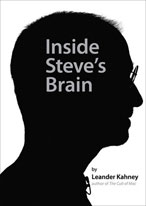 Yesterday I started reading “Inside Steve’s Brain” – a book about Steve Jobs, but more importantly about how he is a master of consumer product design. I’m over a third of the way in and I feel like I’m learning something on almost every page – about him, about successful business practices, about consumer foresight, or about user experience insight. These topics, among others, are rounding out a biographical story not only about what makes Steve Jobs so brilliant and successful, but why Apple is such an intelligent and successful company overall (which is really a reflection of him overall). As I read it, I am also more and more certain that I will finally cave in and buy a Mac laptop come the holidays (I need to sure up my apartment situation first). Among the many things I didn’t know about Steve Jobs…
Yesterday I started reading “Inside Steve’s Brain” – a book about Steve Jobs, but more importantly about how he is a master of consumer product design. I’m over a third of the way in and I feel like I’m learning something on almost every page – about him, about successful business practices, about consumer foresight, or about user experience insight. These topics, among others, are rounding out a biographical story not only about what makes Steve Jobs so brilliant and successful, but why Apple is such an intelligent and successful company overall (which is really a reflection of him overall). As I read it, I am also more and more certain that I will finally cave in and buy a Mac laptop come the holidays (I need to sure up my apartment situation first). Among the many things I didn’t know about Steve Jobs… Starting with his personal life:
- Steve Jobs was adopted (his birth parents must think they gave away a winning lottery ticket
- He’s a college drop out who survived by collecting bottles for pocket change
- He once tried an all apple diet because he thought it would keep him from needing to shower
- After he was ousted from Apple back in the mid 80’s, he was determined to crush Apple by developing two companies
- He found NeXT, a cutting age computer company meant to compete against Apple head on. He later sold NeXT to Apple for nearly half a billion dollars and indirectly the seat back on top of Apple as CEO
- He bought a computer graphics company for $10 million George Lucas when Lucas needed cash for a divorce, and then sold it to Disney years later for $7.4 billion dollars after a string of hits including Toy Story
- As once-again CEO for Apple, he cut a deal with Bill Gates to drop his lawsuit against Microsoft for copyright infringement in exchange for a 5 year commitment to building Microsoft software for Apple, including Microsoft office, the key software that almost every consumer uses
- When he took over Apple the company had an estimated 6 months left of falling profits before bankruptcy
- His core talent was recognizing the need for simplicity in business and design, which is apparent in many of Apple’s successes
- Along with his predecessor, he cut Apple’s product line down from hundreds to only 4, in order to focus the company towards what it could do best and where it could make money; these products, a consumer desktop and laptop, a professional desktop and laptop, were Apple’s only focus for years to come
- Pixar employees are strongly encouraged to take 4 hours per week of continuing education in film, animation, etc, in an on-campus university, regardless if their discipline, to help ensure that employees continue to develop and rank at the top of their game; this has a feel to the much more highly publicized 80/20 rule that Google has pushing employees to continue to experiment on their own projects
His influence on simplicity within Apples products:
- When the Mac Air came out and lacked a CD-Rom it was widely controversial, but this wasn’t the first time Jobs made such a decision; the iMac was the first computer to come without a floppy drive; Jobs recognized this as a fading importance that just added unnecessary bulk to his computer
- The first iPod had the capability for FM radio and voice recording, but Jobs wanted to maintain focus on the ease and functionality of the core purpose of the product, music listening
- Packaging was a critical component – he designs each product packaging so that unpacking the box introduces the consumer to the product in a clear and conceptual way
- Packaging around products like the iPod is meant to showcase the product as if you are buying art
